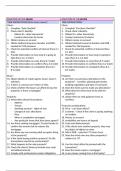Other
PROPERTY LAW: Buying/Selling transaction Complete Outline
- Module
- LPC - Legal Practice Course
- Institution
- LPC - Legal Practice Course
This table is your ultimate guide to property transactions. It provides: CLEAR ORGANISED STAGES: Each stage of a bye-sell transation clearly outlined, from initial agreement to completion. SIDE-BY-SIDE STEPS: Buyer and seller steps listed in two columns for easy comparison and understanding. SEQU...
[Show more]



